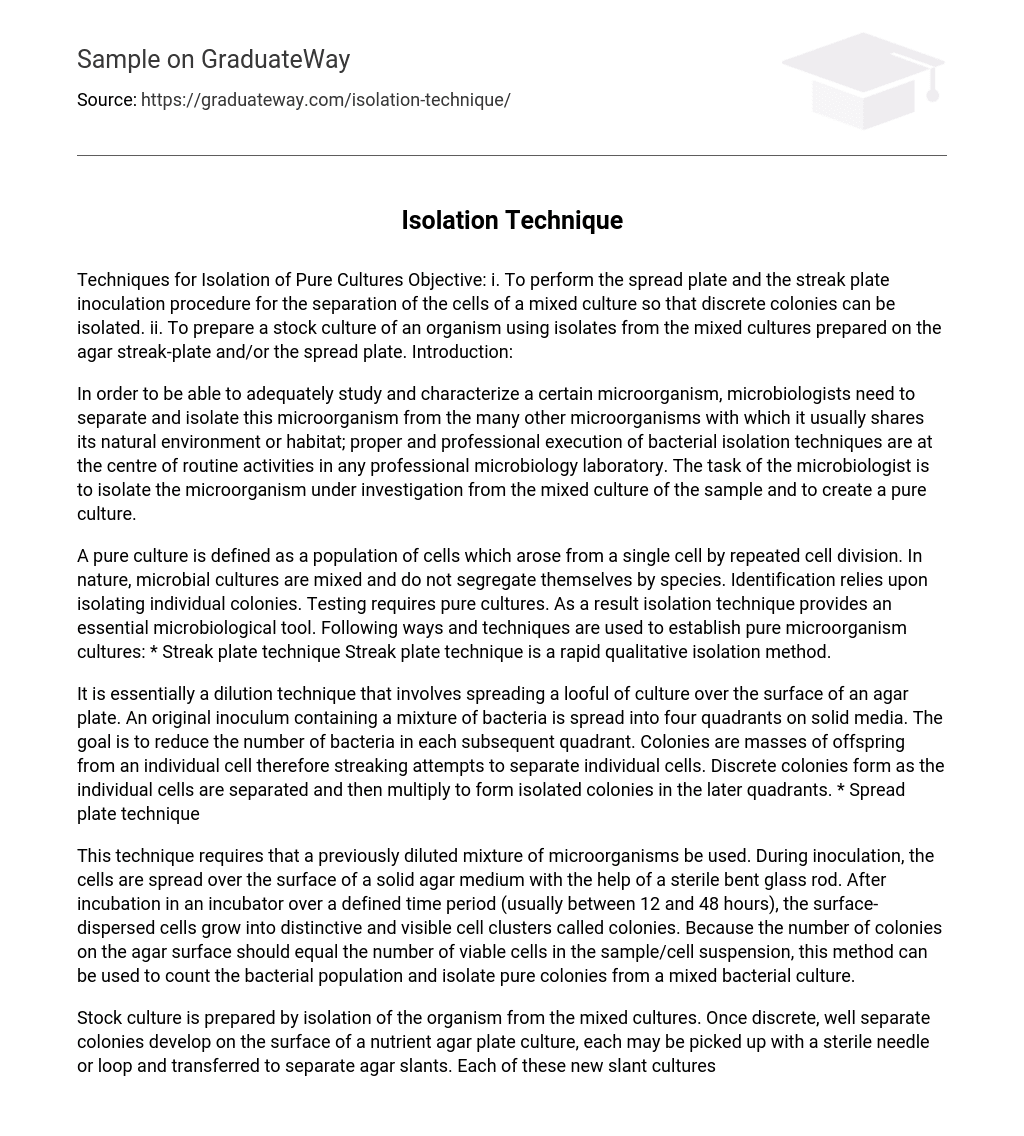Techniques for Isolation of Pure Cultures Objective: i. To perform the spread plate and the streak plate inoculation procedure for the separation of the cells of a mixed culture so that discrete colonies can be isolated. ii. To prepare a stock culture of an organism using isolates from the mixed cultures prepared on the agar streak-plate and/or the spread plate. Introduction:
In order to be able to adequately study and characterize a certain microorganism, microbiologists need to separate and isolate this microorganism from the many other microorganisms with which it usually shares its natural environment or habitat; proper and professional execution of bacterial isolation techniques are at the centre of routine activities in any professional microbiology laboratory. The task of the microbiologist is to isolate the microorganism under investigation from the mixed culture of the sample and to create a pure culture.
A pure culture is defined as a population of cells which arose from a single cell by repeated cell division. In nature, microbial cultures are mixed and do not segregate themselves by species. Identification relies upon isolating individual colonies. Testing requires pure cultures. As a result isolation technique provides an essential microbiological tool. Following ways and techniques are used to establish pure microorganism cultures: * Streak plate technique Streak plate technique is a rapid qualitative isolation method.
It is essentially a dilution technique that involves spreading a looful of culture over the surface of an agar plate. An original inoculum containing a mixture of bacteria is spread into four quadrants on solid media. The goal is to reduce the number of bacteria in each subsequent quadrant. Colonies are masses of offspring from an individual cell therefore streaking attempts to separate individual cells. Discrete colonies form as the individual cells are separated and then multiply to form isolated colonies in the later quadrants. * Spread plate technique
This technique requires that a previously diluted mixture of microorganisms be used. During inoculation, the cells are spread over the surface of a solid agar medium with the help of a sterile bent glass rod. After incubation in an incubator over a defined time period (usually between 12 and 48 hours), the surface-dispersed cells grow into distinctive and visible cell clusters called colonies. Because the number of colonies on the agar surface should equal the number of viable cells in the sample/cell suspension, this method can be used to count the bacterial population and isolate pure colonies from a mixed bacterial culture.
Stock culture is prepared by isolation of the organism from the mixed cultures. Once discrete, well separate colonies develop on the surface of a nutrient agar plate culture, each may be picked up with a sterile needle or loop and transferred to separate agar slants. Each of these new slant cultures represents the growth of a single bacterial species and is designated as a pure or stock culture. Questions: 1. How can a pure culture prepared from a broth culture? To prepare a pure culture from a broth culture, the components from the mixed culture need to be separate first.
This can be done by doing a streak plate or diluting the mixture and using a spread-plate technique. Then, when the individual colonies have obtained it can be grow as a pure culture. 2. What is the function of spread plate technique? The function of the spread plate technique is to grow and isolate colonies of bacteria. The spread plate technique is used for the enumeration of aerobic microorganisms from the given sample. This can be done by serial diluting the samples, placing one drop of the diluted sample in the middle of an agar plate and spreading the sample over the surface with a help of a bent glass rod.
After the incubation the colonies can be counted. This technique evenly distributes bacteria across the plate to make the calculation of the number of bacteria colonies easier, especially when estimating. 3. Observation of a streak plate culture shows more growth in Quadrant 4 than in Quadrant 3. Account this observation. This could be due to human error. For example: no properly sterilizing the inoculating loop or spreading some of quadrant 1 into quadrant 4. This can also be due to the fact that a wider streak is used, so if the microbe is not diluted enough, it can grow more.
Besides, it can be postulated that competition between the more concentrated bacteria in quadrant 3 could result in less growth than in quadrant 4, where the microbes have more resources per individual. 4. How can you determine if the colony that you choose to isolate is a pure culture? Determine by their morphology. Normally when grow microorganisms on nutrient plates they can be differentiated by their appearance, example: colour, size, shape. All microorganisms have different morphological appearances though some can be similar. Besides, the cultures that grow should all look the same; they should have the same cultural characteristics.





